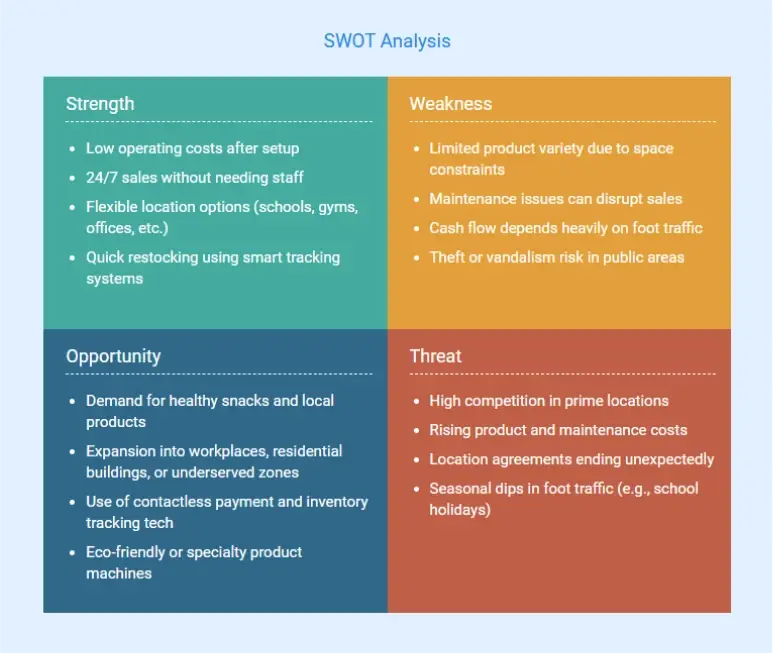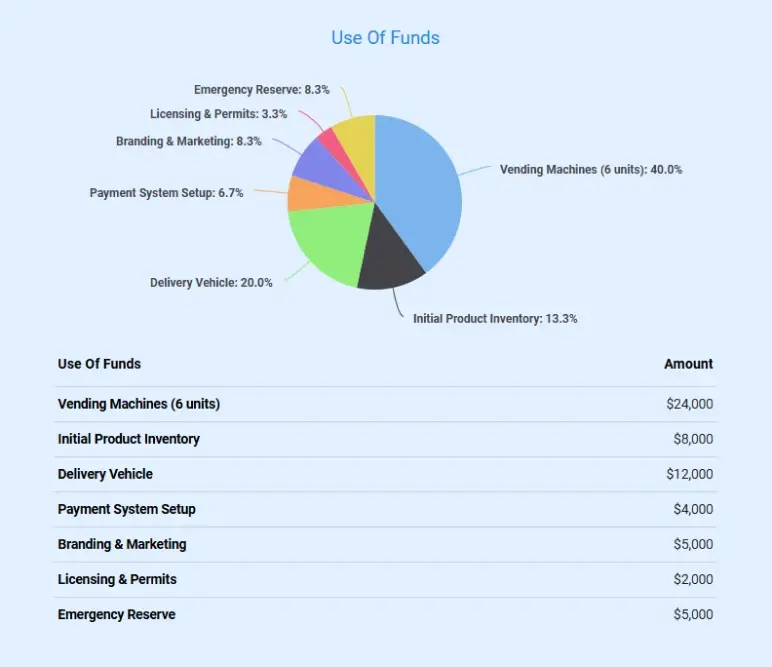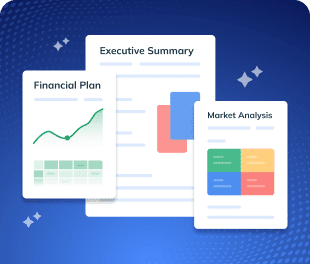Starting a vending machine business? Smart move!
It’s one of those rare business ideas that doesn’t need a fancy setup, a big team, or even a storefront. Just a good machine, the right spot, and snacks people actually want.
But if you want this to work, you can’t wing it.
You need a solid plan that spells out what you’ll sell, where the machines will go, and how the money will come in (and not disappear).
Not sure how to pull that together?
Worry not; this vending machine business plan template is here just for your help!
What is a vending machine business plan?
A vending machine business plan is a written document that shows how your vending business will run. It covers what products you’ll sell, where you’ll place your machines, who your customers are, and how you’ll manage finances and operations.
Think of it as a roadmap to help you stay on track and grow your business effectively. And it’s a must-have if you want to raise money or get a deal with a property manager.
Key components of a vending machine business plan
Here’s a quick list of what to include in your vending machine business plan:
- Executive summary: A brief overview of your business, including your mission, products, target market, and financial highlights.
- Business overview: Details about your company, its structure, and the types of vending machines you’ll operate.
- Industry analysis: Insights into the vending machine industry, including trends, market size, and growth potential.
- Customer analysis: Information about your target customers, their preferences, and buying behaviors.
- Competitive analysis: An evaluation of your competitors and how your business will differentiate itself.
- Sales and marketing strategies: Plans for attracting and retaining customers, including pricing, promotions, and advertising.
- Management team: An overview of the people running the business and their qualifications.
- Operations plan: Details on how the business will function daily, including maintenance and restocking procedures.
- Financial plan: Projections for revenue, expenses, and profitability, along with funding requirements.
How to draft a vending machine business plan?
Writing a vending machine business plan doesn’t have to be complex. You just need to clearly explain what your business does, how it will run, who it serves, and how you plan to make money.
Follow these 9 easy steps to build a plan that works:
1. Executive Summary
The executive summary is a concise overview of your entire vending machine business plan. Although it appears at the beginning of the plan, it’s usually written last, after you’ve detailed everything else.
Think of it as your business’s elevator pitch on paper. If a reader only reads this section, they should still get a clear idea of your business and its potential.
In a few short paragraphs, your executive summary should cover the high-level details of your vending machine business, including:
- Business concept
- Location & ownership
- Target market
- Unique selling proposition
- Financial highlights
- Business goals
Keep this section short and impactful, ideally one page or less. Remember, the goal is to entice the reader to continue reading the rest of your plan.
Be positive and confident, but also realistic. If someone (like an investor) reads your executive summary, they should come away with a clear understanding of what your vending machine business is and why it’ll succeed.
Say goodbye to boring templates
Build your business plan faster and easier with AI
Plans starting from $14/month

2. Business Overview
The company description provides a deeper look into the foundation of your vending machine business. Here, you’ll describe who you are, what you do, and what your business setup is.
This section sets the stage for the rest of the plan by covering the following elements:
- Company overview: State your business name, the products you offer through your vending machines, your legal structure, and your business location (home-based or warehouse-based).
- Mission and vision: Include a short mission that reflects your purpose and a vision that outlines your long-term goal.
- History and stage: Mention why you started the business and any early milestones or traction if already operating.
- Services and specialty: List your main product categories (snacks, drinks, healthy options) and highlight any specialty like smart vending technology or location-specific product mixes.
- Business structure and team: Outline your company structure and mention any partners or team members.
- Goals and objectives: Share short-term goals (like breakeven timeline) and long-term goals (like expansion plans).
By the end of this section, the reader should understand your business identity, current stage, and direction. It answers: “Who’s this business and why does it exist?” clearly and confidently.
3. Industry Analysis
The industry and market opportunity section explains why a vending machine business is understood today. The industry and market opportunity section explains why a vending machine business makes sense today. This is your chance to show that vending isn’t just passive income—it’s part of a fast-growing, tech-friendly industry.
You’ll also highlight trends, data, and local opportunities that support your business plan. You will also highlight trends, data, and local opportunities that support your business plan.
When writing this section, include the following major parts:
Industry Overview
In this section, state that vending is a serious business, not just a side hustle. Prove that the opportunity is real and growing.
Market Size and Demand
In 2024, the U.S. vending machine industry is expected to reach $15 billion. Include clear stats on total market size, annual sales, and rising demand for contactless payments and healthier product options.
Technology and Industry Trends
Highlight major trends: smart tracking, card-cavalry machine, mobile payment, environmentally friendly packaging, and location-specific snacks.
Local Market Interval
Indicate local opportunities, such as underscribed offices, growing industrial parks, schools without a cafeteria on site, or without snack access fitness centers.
By clearly covering these elements, you will show lenders, partners, or stakeholders that you understand where the vending industry is – and how your business fits.
4. Customer Analysis
This customer analysis section helps you explain who your customers are, what they expect from vending machines, and how your product choices and placement match their needs.
A strong customer analysis shows you’ve thought through who’s buying, when, where, and why.
Here are a few key areas to cover:
Target customer profile
Start by describing who your ideal customers are. These might include:
- Office staff looking for quick lunch or snack options during short breaks
- College students are grabbing energy drinks or snacks between classes
- Gym members looking for protein bars or recovery drinks
- Commuters and travelers at bus or train stations need convenient, on-the-go items
Be specific about the types of places you’ll target and who’s most likely to use the machines there.
Customer needs and expectations
Explain what matters most to your users. This could include:
- Fast service with no waiting
- Simple, modern payment options (card, mobile, contactless)
- Affordable prices that fit daily budgets
- Clean, well-stocked machines that are easy to use
Mention how your machines will meet or exceed these expectations.
Buying habits and preferences
- Share what you know or expect about their habits:
- When do they buy (mornings, lunch breaks, late evenings)?
- How often—once a day, a few times a week?
What do they buy most—salty snacks, energy drinks, protein snacks, or healthier options? Will they respond well to limited-time offers, bundles, or loyalty QR codes?
If you’ve done any local surveys or informal research, add those findings here.
5. Competitive Analysis
The vending machine industry is competitive, especially in areas with high foot traffic where multiple operators are already active. To succeed, you need to do some basic competitor research. This proves that you understand your local market and have a clear plan to offer something better or more convenient.
In this section, you’ll list your top competitors, analyze what they do well, and explain how your vending business will offer a better experience.
Here’s how to write this part effectively:
Step 1: List the major vending operators in your area. These could be companies managing multiple machines in offices, schools, or public buildings—or even individuals running independent machines in high-traffic spots.
Step 2: Collect details on what products they sell, what types of machines they use, how they price items, and what kind of locations they target. Use site visits, online reviews, or public listings to gather this info.
Step 3: Compare their setups to your planned offering. Are they using card-only machines? Do they stock healthy snacks? Are machines well-maintained? What do customers complain about—empty machines, limited choices, high prices?
Step 4: Write down how your vending business will stand out. Maybe you’ll stock local products, use smart tracking to avoid sell-outs, offer better pricing, or place machines in overlooked but high-need areas.
Step 5: Identify service gaps. If no one serves night-shift workers, fitness centers, or industrial parks, and you plan to—call that out clearly.
Before you write your competitive strategy, consider doing a quick SWOT analysis. It helps you sum up what you do well (Strengths), where you might lag (Weaknesses), where the market has room (Opportunities), and what risks to plan for (Threats).

Use this analysis to write a short competitive strategy. Think about location selection, pricing, product mix, customer service, or restocking speed.
Doing this research shows potential partners and investors that you know the local vending landscape—and that you’re prepared to compete with a real plan.
6. Sales and Marketing Strategies
Having well-placed machines and a great product mix is important—but none of it matters if people don’t notice or use your machines. This section explains how you’ll make your vending business visible, drive traffic to your locations, and keep usage (and profits) growing.
Marketing Strategy
Your main goal is visibility. People need to know your machines are there, stocked, and worth using. Focus on local awareness and practical promotion strategies like:
- Add bold, branded signage on all machines to attract attention
- Place machines in high-traffic, high-need locations (gyms, offices, schools)
- Create a simple website or landing page showing your machine types, locations, and contact info
- Use Google My Business to list your vending business with photos and reviews
- Run local Facebook or Instagram ads to highlight machine availability, snack options, or new locations
- Offer placement incentives or revenue sharing to property owners
Sales Strategy
Once your machines are in place, the focus shifts to driving steady usage. That means optimizing your product selection, pricing, and experience. Consider:
- Stocking high-demand items based on each location (e.g., protein bars at gyms, energy drinks in office buildings)
- Keeping machines well-stocked and clean at all times
- Using smart vending tools to track sales, reduce downtime, and rotate slow-moving items
- Testing limited-time promotions or bundle pricing (e.g., buy 2, get 1 free)
- Encouraging customer feedback through QR codes or contact info on the machine
This shows you’re not just putting machines out and hoping for the best—you’re actively managing your business to attract attention, keep customers coming back, and grow your reach over time.
7. Management Team
Investors and partners don’t only look at the business—they see the people running it. This section shows who is behind the vending machine business and why they are a perfect fit.
If you’re the founder, introduce yourself and give a small background. Mention any experience in retail, operations, logistics, or small business.
This helps you understand what it seems to stock, work, and keep the machines profitable.
If you have co-founders or major team members, list them here. For each individual, include their name, role, main responsibilities, and any relevant experience – such as delivery, customer service, or managing technical support.
You can also include a simple org chart here to show team roles clearly at a glance.

If you have outside support, such as a vending supplier rep, small business advisor, or technician on-call, mention them briefly.
The goal is to show that the business is in capable hands, with a team (or solo operator) who knows how to run things day-to-day and grow smartly over time.
8. Operations Plan
The operations plan explains how your vending machine business will run day to day. While earlier sections focus on what you’re offering, this part shows how you’ll keep everything working behind the scenes.
Here’s what to include in your vending operations plan:
- Where will you operate from? State if you’ll work from home, a small office, or a storage unit, and where you’ll store inventory.
- What equipment do you need? List your machines, any tools for stocking (like a van or cart), and software for sales or inventory tracking.
- Who’s running daily operations? Mention if you’ll handle restocking and support yourself or hire part-time help.
- How will you restock and maintain machines? Say how often you’ll restock, monitor machines, and manage basic repairs.
- How will you manage payments and refunds? Note if you’re using cashless systems and how customers can request refunds.
- How will you ensure quality and reliability? Explain how you’ll keep machines clean, stocked, and products fresh.
This section should show that you’ve planned the details and can keep the business running smoothly, reliably, and efficiently.
9. Financial Plan
The financial plan is the place where you convert your vending business ideas into numbers. This section proves that the business is financially viable and is particularly important for investors or lenders.
Your estimates should cover the next 3-5 years and include the following major components:
Revenue estimates
Product pricing, average daily transactions, and an estimated income from the sale of machines based on the number of active machines.
Operating expenditure
List recurring costs such as product restoration, fuel for delivery, maintenance and repair, machine management software, and any part-time labor or support services.
One-time startup cost
Cover early expenses such as purchasing vending machines, installing payment systems (eg, card readers), initial product list, vehicle for delivery, branding or signage, license, and business setup fee.
Profit and loss
Estimate your annual profit or loss based on estimated revenue and expenses.
Cash flow forecasts
Show how the money will flow from the sale of the machine and how it will be spent on inventory, operations, maintenance, and other costs.
Balance Sheet
To present a complete picture of financial health, submit your business property and owner equity.
If you’re requesting funding, clearly state how much you need and what it will be used for—for example, buying machines, a delivery vehicle, or expanding into new locations. You can also include a simple “Use of Funds” chart to make this information easier to understand.
We’re seeking $60,000 in startup funding to cover essential costs and support early expansion.

Finally, don’t forget to include your major financial beliefs, such as average sales per machine per day, product margin, and frequency. They should align with your comprehensive plan and help to validate your estimates.
Download a vending machine business plan template
Drafting a business plan can be a lot of work, especially if it’s your first time. The good news is you don’t have to start from scratch. Use our free vending machine business plan template to jump-start the process.
This sample plan is designed for aspiring vending machine operators (like you) and includes example sections and financial charts, which can guide you on what to write in each part of your plan. You can even customize it to reflect your business’s unique needs.
The Quickest Way to turn a Business Idea into a Business Plan
Fill-in-the-blanks and automatic financials make it easy.
Prepare your business plan in Upmetrics
Now that you’ve explored this detailed guide and a free template, writing your vending machine business plan should be much easier.
However, if you’re still looking for speed things up, try using Upmetrics. It’s a modern, AI-powered business planning tool that helps you create a professional-looking plan in just a few minutes.
With ready-to-use templates and built-in financial forecasting features, it makes the planning process a breeze for you. And if you’re raising funds or pitching to location owners, you’ll also get a clean, polished pitch deck ready to send.
Start your vending business today—with a real plan behind it.



